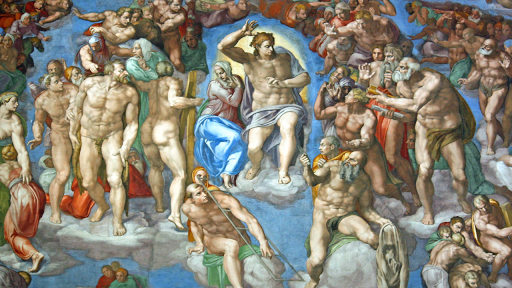Anyone who’s been fortunate to visit Rome, go to their museums, spend time in the great Churches and massive Basilica’s can attest that it is often a sensory overload. Your first time entering into some of these historic, exquisitely beautiful – and most of all – sacred places, most likely you don’t know where to look first… What the meaning or significance to all of the things you’re taking in, means… How human beings were able to accomplish such wonders. You walk into St. Peter’s Square, see this massive edifice and marvel at the complexity of such a structure. You enter into the Vatican Museums and find yourself walking literally for miles through centuries upon centuries of creativity unleashed in a variety of artistic forms. The end of that journey brings you to the Sistine Chapel where you find yourself simply in awe at the genius of it all. What makes art and beauty such a divine institution is that you can really be affected and moved by all of those things, even if you were only able to spend a few moments in these places.
Hi everyone here’s my homily for the 32nd SUNDAY IN ORDINARY TIME, November 8, 2020. Thanks so much for stopping by to read this and even more for sharing it on your Facebook, Twitter, Instagram and everywhere else people share social media posts and your feedback and comments! For the audio version you can get them at SOUNDCLOUD click HERE or from ITUNES as a podcast HERE. Thanks again… I hope you and yours experience all of God’s blessings today and always! In Christ – Father Jim
If you have more time to view, and engage the art, you find some deeper lessons being conveyed. The frescos by Michaelangelo in the Sistine Chapel are amazing. These masterpieces tell the story of human history: from the dawn of God’s creation to the end times. The whole ceiling has God’s love story. His creation, His love for humanity, how often humanity fell away, how God continued to bring us back, create a way to save humanity – which is perfected and fulfilled in Jesus Christ. It’s meant to move people on multiple levels. To appreciate the beauty of the work itself. To remember our origins and the love of God who desires our choosing to love Him. To reflect on where are we now and where are we going? You’re meant to look around at all the figures, all the stories of the best and worst of humanity being played out and to ask yourself, who am I? Where do I fit in? Am I one of the crowd, am I the drunk guy, the sinner striving to become a Saint? Which reaches it’s culmination in it’s fullness on the back wall where “the Final Judgment” is depicted.
If you can get past the artistic splendor – which is a challenge – you find all kinds of additional details that capture your attention. There’s little things and details like the story about one Cardinal who publicly criticized Michelangelo’s work ends up being depicted in hell in what one might imagine as being the worst possible of manners… or how there’s no women depicted in hell because Michelangelo couldn’t conceive of any woman ending up there.

One lasting image that has stayed with me from the first time I saw it and having the art expert (Liz Lev – if you have an hour or so, and want to listen to her give some amazing information, she’s fascinating to listen to: https://www.youtube.com/watch?v=b5DcbqN1mQA&t=2824s ) who was our guide explained it was the image of Christ himself on that wall in the Final Judgment. Jesus is beardless, which is somewhat rare for us to see in art, and that adds to the majestic, serious tone. His right hand is raised as he’s passing judgment and looking at those damned to hell. To his side, the Blessed Virgin Mary is there portrayed with a mix of emotion. The scene makes it seem like Jesus has his back to Mary and can no longer hear her intercede for them – it’s too late.
It’s stirring. Michelangelo had wanted the importance of how we lived our lives and how we would be judged to be front and center for those who came into that sacred of spaces. To be challenged, to be uncomfortable and moved into having some reaction. To recognize there will come a final judgment where we will have an accounting for who we are and how we have lived. The need for the observer of the painting to consider the importance of repentance, to have a change of heart, to turn away from sin and to turn towards Christ before that final judgment takes place… before it’s too late.
That image came to mind when reflecting on what Jesus is sharing in this somewhat confusing parable. The imagery and background to this is so foreign to us, it can be easy to dismiss it. We hear about a wedding, lamps and oil and wonder why some of these people are being un-Christian and not sharing their oil with people who need some… why is the groom seem unforgiving to these people who are asking for some understanding and compassion?
To Jesus’ initial listeners, hearing this parable – they knew weddings to be“the event” of the year – the whole town would be buzzing about it. There would be great anticipation, and preparation for it. For the first-century Jewish wedding, it would begin after sunset. The bridesmaids, after spending time with the bride, would go out and wait to meet the bridegroom. One of their responsibilities was to accompany the groom to the bride and since it was dark, they would carry an oil lamp. That these unfortunate ones in this parable didn’t have enough, well, in 2020 language they had one job. The other bridesmaids couldn’t share the oil because then they would not be able to fulfill their responsibility.
The deeper meaning though is meant for us to recognize Jesus as the Groom and the Church is her Bride. Jesus is asking his followers, are we prepared to welcome Him? To escort Him to His bride? To be ready to be apart and join in the great celebration when the big day arrives? That’s an individual and presonal question that every individual needs to answer for themselves.
The “oil” in “our lamps” isn’t something that can be shared. The oil is our personal virtue. One religious writer put it, The wise virgins “represent all those who possess the ensemble of virtues which characterize a complete Christian life.” When we see the parable from this understanding, the dramatic differences between the wise and foolish maidens become more obvious.
The wise choose to live chastely rather than the foolish one to give into lust;
the wise have self-control and restraint rather than getting drunk or high.
The wise choose to be charitable rather than give into greed;
The wise are hardworking rather than lazy; are patient rather than giving into rage; are
kind and grateful for their blessings rather than envious or jealous.
The wise who are humble rather than the foolish who’s pride and ego’s are way out of control.
Like a beautiful artistic treasure like the Sistine Chapel, we can sometimes get lost in the abundance of goodness we’re accustomed to seeing when looking at Jesus – Yes He is loving, He is merciful, He is compassionate. And that’s why Jesus’ warnings in Gospel passages like this are meant to be a blessing to us. To cause us to look at our faith lives more seriously. To consider that if our oil is low now to take advantage of the opportunity to get a fill up. Jesus can forgive our negligence – He can assist us by offering us the absolution from our sins that we need when we do a thorough examination of conscience, go and make a good confession. He offers us generous amounts of His grace hoping we will utilize it to be truly wise and prepared. Because the day He arrives, whether it’s at the end of time or the end of our time – is something that we know is coming. It is “the event” that every human being knows is inevitable… The exact timing isn’t something we are clear on. Will we be prepared to greet him when He comes? May we be busy and intent on those things, before it’s too late.











